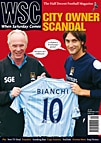 Having a fag at matches was all but outlawed on July 1 and football has been pushing tobacco away for a while. But, as Jon Spurling explains, the game and the weed have had a surprisingly close relationship
Having a fag at matches was all but outlawed on July 1 and football has been pushing tobacco away for a while. But, as Jon Spurling explains, the game and the weed have had a surprisingly close relationship
“There’s nothing better than lying back in the bath and having a good smoke after a game,” claimed Bolton striker Nat Lofthouse in the 1950s. This post-match relaxation technique has long been consigned to the historical dustbin, so much so that there is always a frisson of disapproval whenever a high-profile footballer is caught with a cigarette. Zinedine Zidane, having previously endorsed the EU’s “Feel Free To Say No” campaign, was castigated by the French media after being snapped taking a crafty drag shortly before France’s semi-final against Portugal at last year’s World Cup. With FIFA and UEFA refusing to allow tobacco advertising at any international tournaments over the last eight years, the previously strong ties between the tobacco industry and football appear to have been severed.
As far back as the 19th century, cigarette companies quickly realised that football was an excellent medium through which to obtain brand loyalty among fans, in addition to the eminently collectable cards. Over the years a series of high-profile players rushed to endorse tobacco products. In the 1930s, Everton’s Dixie Dean promoted Carreras Clubs (“Cigarettes with a kick in them”) and Stanley Matthews – a devout non-smoker – promoted Craven ‘A’ (“Stanley’s smooth ball control matches the smoothness of Craven ‘A’”). Former Manchester United defender Charlie Roberts, having bought a tobacco business after his retirement, designed Ducrobel cigarettes, named after United’s backline of Dick Duckworth, Charlie Roberts and Alex Bell. Arsenal star Alex James was snapped puffing away with transatlantic flyer Amy Johnson and Wimbledon champion Suzanne Lenglen in his role as sports-equipment promoter at Selfridges.
Cigarettes were part and parcel of the working man’s game, with smoking permitted on the trains and buses that ferried fans to games, and tobacco advertised in programmes and on hoardings around the ground. Newcastle star Jackie Milburn, who was regularly seen handing out cigarettes to fans after matches, recalled how, after slipping away for a surreptitious smoke before the 1951 FA Cup final, he was “shocked to discover four of my team-mates puffing away in the toilet. They told me they’d cadged them off fans beforehand.” “When you swept the terraces at the end of matches in the Fifties,” recalled former Villa employee George Sander, “there was a mountain of newspaper and dog-ends, as far as the eye could see. The only exception was for Christmas games, when chaps would be smoking cigars they’d received as presents.”
By the early Seventies, many upwardly mobile players and managers were flaunting their new-found wealth by chomping on fat cigars. ITV’s pioneering 1970 World Cup panel vented their opinions through a haze of Havana smoke – “I’ve got a contact in Cuba who sorts me out,” said star panellist Malcolm Allison. Brian Clough and Peter Taylor were rarely seen without their favoured cheroots on the touchline at the Baseball Ground, and early publicity shots of “The Clan” (a collection of football wide boys comprising stars such as Alan Ball, Alan Hudson and Stan Bowles) showed them puffing away on cigars and sipping champagne in a plush King’s Road eaterie.
Others’ well publicised nicotine habits simply reinforced their rebellious streaks. Johan Cruyff, who insisted on keeping two stripes on his Dutch shirt instead of the regulation three of the sponsors Adidas, also resisted attempts by the national team’s medical staff to make him kick his 20‑a‑day habit (he only gave up in the 1990s, following heart-bypass surgery). After joining Derby, Charlie George took up smoking before matches in an attempt to stop himself being physically sick, and Argentina coach César Luis Menotti, who openly criticised the controlling military junta, added to his anti-hero image by chain-smoking on the touchline throughout the 1978 World Cup.
Programmes in the later Eighties still contained tobacco adverts, with the ubiquitous government health warnings. But the Popplewell Inquiry following the Bradford fire highlighted the dangers of fans smoking in rickety wooden stands and, with stadiums being rebuilt and clubs targeting family audiences, smoking bans began to be mooted. As a new generation of health‑conscious coaches came to prominence, nicotine-stained footballers have been viewed with growing disgust. Before the 1998 World Cup, Glenn Hoddle was attacked by the anti-smoking lobby for refusing to clamp down on Paul Gascoigne’s habit, and even Alex Ferguson was forced to vigorously defend himself after permitting Fabien Barthez to puff away in private. Joey Barton’s stubbing out of a cigar in a team-mate’s eye at Manchester City’s Christmas party symbolised the sheer irresponsibility of grotesquely wealthy Premiership stars.
Typically, Gazza rounded on “the health fascists”, claiming: “That’s the problem with football today. Players are expected to eat the same, drink the same and behave the same. They can’t do this, they can’t do that. No wonder they’re all becoming little robots.” With the majority of clubs having banned smoking in grounds long before the recent government legislation, the air is certainly far cleaner at games today. Yet with the atmosphere inside many spanking new stadiums depressingly sterile, you occasionally yearn for a wisp of fetid air to drift up your nostrils and stimulate the senses.
From WSC 247 September 2007